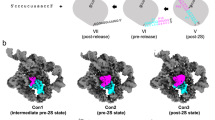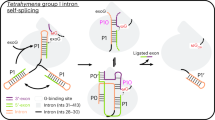Abstract
IN large structured RNAs, RNA hairpins in which the strands of the duplex stem are connected by a tetraloop of the consensus sequence 5′-GNRA (where N is any nucleotide, and R is either G or A) are unusually frequent1. In group I introns there is a covaria-tion in sequence between nucleotides in the third and fourth positions of the loop with specific distant base pairs in putative RNA duplex stems2: GNAA loops correlate with successive 5'-C-C · G-G base pairs in stems, whereas GNGA loops correlate with 5′-C-U · G-A. This has led to the suggestion that GNRA tetraloops may be involved in specific long-range tertiary inter-actions, with each A in position 3 or 4 of the loop interacting with a C-G base pair in the duplex, and G in position 3 interacting with a U-A base pair. This idea is supported experimentally for the GAAA loop of the P5b extension of the group I intron of Tetrahy-mena thermophilc3 and the L9 GUGA terminal loop of the td intron of bacteriophage T4 (ref. 4). NMR has revealed the overall structure of the tetraloop for 12-nucleotide hairpins with GCAA and GAAA loops5 and models have been proposed for the inter-action of GNRA tetraloops with base pairs in the minor groove of A-form RNA2,4. Here we describe the crystal structure of an intermolecular complex between a GAAA tetraloop and an RNA helix. The interactions we observe correlate with the specificity of GNRA tetraloops inferred from phylogenetic studies, suggesting that this complex is a legitimate model for intramolecular tertiary interactions mediated by GNRA tetraloops in large structured RNAs.
This is a preview of subscription content, access via your institution
Access options
Subscribe to this journal
Receive 51 print issues and online access
$199.00 per year
only $3.90 per issue
Buy this article
- Purchase on Springer Link
- Instant access to full article PDF
Prices may be subject to local taxes which are calculated during checkout
Similar content being viewed by others
References
Woese, C. R., Winker, S. & Gutell, R. R. Proc. natn. Acad. Sci. U.S.A. 87, 8467–8471 (1990).
Michel, F. & Westhof, E. J. molec. Biol. 216, 585–610 (1990).
Murphy, F. L. & Cech, T. R. J. molec. Biol. 236, 49–63 (1994).
Jaeger, L., Michel, F. & Westhof, E. J. molec. Biol. 236, 1271–1276 (1994).
Heus, H. A. & Pardi, A. Science 253, 191–194 (1991).
Pley, H. W., Flaherty, K. M. & McKay, D. B. Nature 372, 68–74 (1994).
Author information
Authors and Affiliations
Rights and permissions
About this article
Cite this article
Pley, H., Flaherty, K. & McKay, D. Model for an RNA tertiary interaction from the structure of an intermolecular complex between a GAAA tetraloop and an RNA helix. Nature 372, 111–113 (1994). https://doi.org/10.1038/372111a0
Received:
Accepted:
Issue Date:
DOI: https://doi.org/10.1038/372111a0
This article is cited by
-
Molecular analysis of the role of IRES stem-loop V in replicative capacities and translation efficiencies of Coxsackievirus B3 mutants
Molecular Biology Reports (2009)
-
Classification and Structure of Echovirus 5′-UTR Sequences
Virus Genes (2005)
-
Multiple group I introns detected in the nuclear small subunit rDNA of the autosporic green alga Selenastrum capricornutum
Current Genetics (2004)
Comments
By submitting a comment you agree to abide by our Terms and Community Guidelines. If you find something abusive or that does not comply with our terms or guidelines please flag it as inappropriate.



